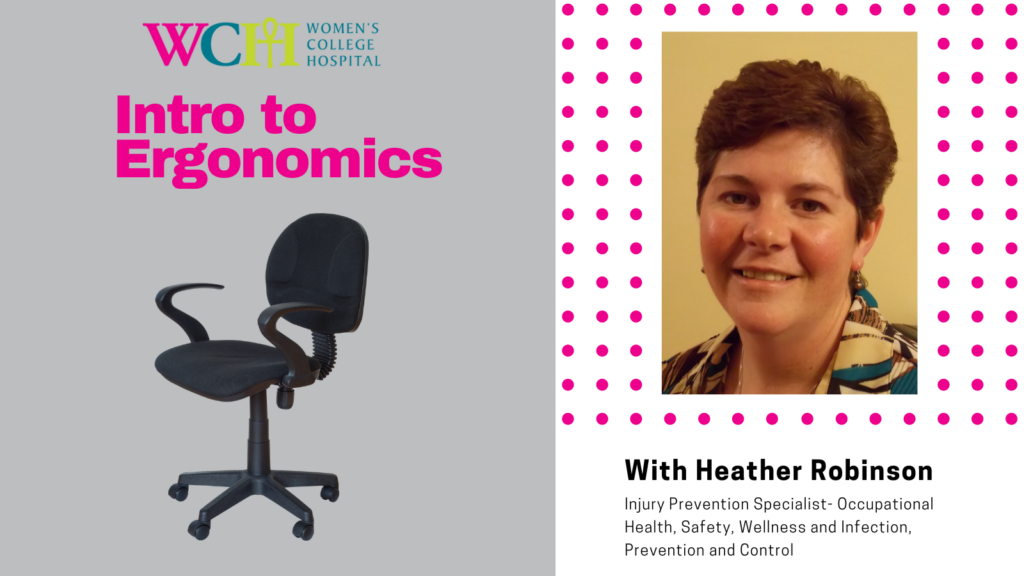For this special Wellness feature, we asked Heather about the importance of ergonomics in the workplace and how good ergonomics habits can benefit employees in the long term.

Heather Robinson is an Injury Prevention Specialist working in Occupational Health, Safety, Wellness and Infection, Prevention and Control. She has been working at Women’s College Hospital for nearly 27 years, and with her background in kinesiology and athletics therapy, she has provided guidance on topics related to ergonomics, safe lifting and injury prevention throughout her career. With this expertise in mind, we sat down with Heather to tap into her knowledge about the importance of ergonomics in the workplace.
Congratulations on nearly 27 years at WCH! What has kept you working here all these years?
Working at WCH has always been about the joy I get from working with people whether they are staff, physicians, learners or patients. I have been here so long and have seen so many changes, but the constant that makes working here so great is the wonderful team of people that are a pleasure to work with each and every day. In my previous roles, my time was spent with patients who are so appreciative of the many services WCH provides. In my current role, I get to help the staff who make this facility world renowned and a leader in the area of ambulatory care. This is a special place, and I am grateful every day to be a small part of it.
Why do you feel Wellness is important to the WCH team?
As the Injury Prevention Specialist, my job is to provide education and training on safe work practices which is a significant factor of the health and wellness of Our People. I work collaboratively with our Wellness and Safety Specialists to determine how we can best prevent incidents as well as assist staff to have an early and safe return to work when they are ill or injured.
What is ergonomics?
Ergonomics is the study of people at work with the goal of arranging the work environment so that people work as efficiently and safely as possible to prevent injury. The focus of ergonomics is in changing the work environment to suit the worker rather than forcing the worker to adapt to their surroundings.
What are the benefits of good ergonomics?
The benefits of good ergonomics range from reducing injuries and costs associated from lost time to improved quality of work. Workers who are able to manage their pain tend to be happier and have more job satisfaction.
What are the effects of bad ergonomics?
The short-term effects of poor ergonomics can be neck, back, shoulder and arm pain, headaches and even repetitive strain injuries. More long-term effects can include musculoskeletal complaints such as carpal tunnel syndrome, chronic back pain and rotator cuff injuries. As pain often limits activity, this can affect illnesses such as obesity, diabetes, heart conditions and stroke.
How can ergonomics prevent injury?
By practicing correct working postures and movements and adapting the workspace to the employee, the physical stress to the employee’s body is reduced and the risk for injuries and pain related to poor posture can be avoided.
What are some tips for staying healthy while at work?
Take care of your eyes by taking “focus” breaks- every 20 minutes, look at something 20 feet away for at least 20 seconds and by ensuring your monitor is directly in front of you, an arm’s length away and the top is just below eye level.
Stay active at work by taking the stairs instead of the elevator, going for water breaks to encourage movement, standing for phone calls or walking to speak with a colleague instead of emailing or calling.
Add stretch breaks to your day to reduce muscular tension and stiffness from sitting too long.
Add exercise to your day by walking an extra subway or bus stop on your way to or from work or go for a walk at lunch on your own or with a coworker. Health Canada recommends 150 minutes of aerobic exercise per week which can be accomplished in 10- minute chunks of time.
What are your hopes for the future of ergonomics?
I hope that all people become aware and take advantage of ergonomics support programs in their organizations so that everyone will be working comfortably at their desk, reducing the common aches and pains that interrupt our work and home life. There are so many small changes that can be made to positioning and equipment that can make a huge difference.